Our Collection
Bennett Brook Railway preserves and operates a large collection of ex- West Australian government and privately-owned railway and tramway equipment and structures. This section is presently under construction, and will be expanded frequently.
Locomotives
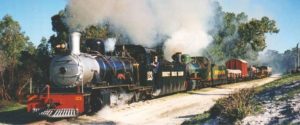
The NG15 class of locomotives were originally built for use on 2ft lines in South-West Africa (now Namibia) in 1931. 21 locomotives were ordered in batches from Henschel in 1931, 1938 and 1957, and from Franco-Belge in 1949 and 1952. NG 118 is part of the 1938 batch of 3 engines from Henschel, while NG123 was part of the first order from Franco-Belge in 1949.
When the railways in Namibia were converted to 3’6″ gauge in 1960, the entire class was relocated to Port Elizabeth in South Africa, where they ran on the Avontuur line until the 1990s. NG118 was placed out of service following an accident in July 1982, and NG123 was out of service by February 1983
A large number of the class still exist in preservation worldwide, including NG118 and NG123 with the BBR. These locomotives were purchased from the South African Railways in 1984, and arrived in WA in 1985. Both NG118 and NG123 have been charismatic and powerful performers for the BBR over the last 30 years, and are a well-established part of the steam preservation scene in West Australia.
The NG15 is considered to be the largest and most powerful type of non-articulated 2ft gauge steam locomotive in the world.
Technical details for the NG15s can be found HERE.
More information and pictures of NG15s in service in South Africa can be found in Soul of a Railway by Les Pivnic and Charlie Lewis.
NG 118 is stored out of service, pending overhaul. NG 123 is under overhaul, is expected to return to service in early 2025.


This small locomotive was built by Perry Engineering in South Australia in 1939. It was purchased by the Inkerman Mill in Home Hill, Queensland. It worked as a mill shunter, replacing an older Hunslet locomotive of similar size and power (This locomotive, ‘Torpedo,’ has been preserved in Junee, NSW).
After being retired in 1966, it was used as a childrens’ playgound item in Queensland. BBR member Malcolm Thompson purchased the locomotive in 1990, brought it to WA and restored it for use on the BBR. Restoration was completed in 1996, and Malcolm was able to drive his locomotive before his death in 1997.
Originally named ‘Adelaide’ while in mill service, Malcolm renamed the locomotive after his wife. It has been known as ‘Betty Thompson’ ever since.
This locomotive is in service. It hauls weekend trains between May and September, weather permitting.
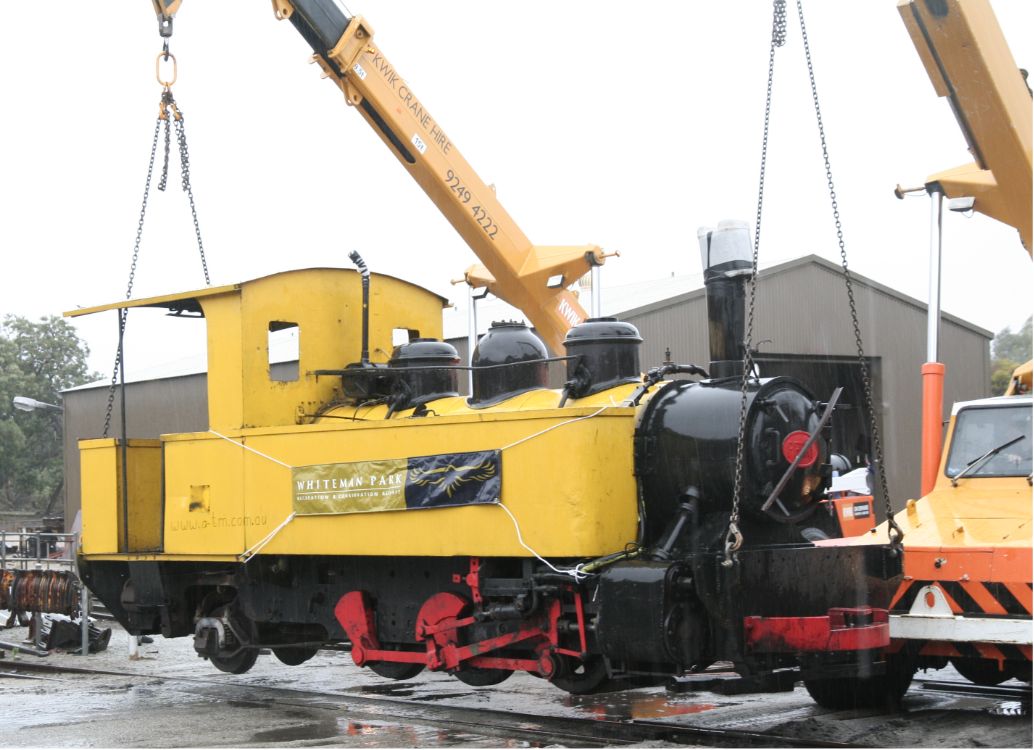
This locomotive was built for service at the sugar mill in Marian, Queensland. It was retired from service in the late 1970s or early 1980s, and by the early 1990s was running at Melaleuca Station, a tourist location in Chinderah, NSW. The locomotive was purchased by BBR in 2009 and transported to Whiteman Park. It was purchased as a running locomotive, but on closer examination it was found that more detailed restoration was required.
This locomotive is larger and more powerful than BT1, and its contemporaries are considered to be free-steaming and reliable locomotives. It will be an appreciated addition to the BBR’s motive power roster.
This locomotive is under restoration.
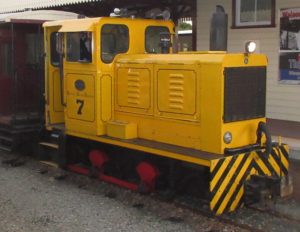
Built in 1938 by F.C. Hibberd for Lake View & Star Gold Mines in Kalgoorlie. This was the second of 2 such ‘Planet’ locomotives made for the LV&S, and was F.C. Hibberd’s first rod-driven design. The locomotive hauled loads of rock from mine head to crushing plant until the mine was closed down in 1975. The Planet and some of its hoppers formed the first ever purchase by the West Australian Light Railway Preservation Association, and it has been a mainstay of BBR operations to the present day.
In 1991, the original Atlantic motor in the locomotive was completely worn out. The locomotive was rebuilt with an ex-WAGR Track Machine 3-cylinder GM 53-series motor and fluid drive. Cab height was increased by 12 inches to improve ergonomics for the driver. The locomotive received new wheels in 2014.
This locomotive is currently in service, pulling weekend train services.

This locomotive was purchased by the Great Boulder Mining Company in 1962 for its tramway operations. It replaced the O&K Mallet, which is also preserved by BBR.
This locomotive is fitted with a 6 cylinder Dorman motor, and is significantly larger than its ex-Lake View and Star predecessor. Interestingly, Great Boulder was bought out by LV&S in the early 1970s, meaning that the locomotives were worked by the same company for a time.
Originally preserved by the Boulder Loopline railway in Kalgoorlie, the locomotive was privately purchased by 2 BBR members, and delivered to Whiteman Park in 1998.
This locomotive is currently out of service, pending overhaul.
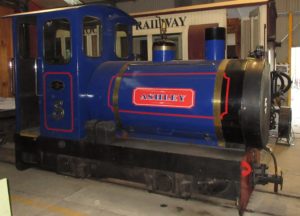
This locomotive was built by Kless Engineering of Maribyrnong, NSW in 1985 for the Big Orange theme park in Harvey, WA. On its closure in 1994, the locomotive and its carriages were purchased by the Brajkovich family for their Dizzy Lamb theme park. This in turn closed down in 2000.
The locomotive and its stock were offered to the BBR in 2004, and a long-term loan arrangement was made in 2005. By 2006, both locomotive (now dubbed ‘Ashley’) and its rolling stock were located on the railway and running passenger services.
The BBR progressively paid out the Brajkovich family for their stock, making its final payment in October 2019.
Ashley has become the centrepoint of the BBR’s ‘Friends of Ashley’ events, and is an ergonomic and powerful locomotive for its size.
This locomotive is currently in service, hauling mid-week and special event train services.

This locomotive was built by Fowler of Leeds, UK in 1950 for the Isis Central sugar mill in Queensland. By 1954, its original Mclaren motor was completely worn out, and it was remotored with a GM 6 cylinder motor by Bundaberg Foundry. It was retired from service in 1991, and purchased by BBR and delivered to WA in 1992.
The locomotive was named ‘Rosalie’ in honour of Roaslie (Lee) Heaney, a Park Ranger who was killed that year by a rockslide while holidaying in the USA. Rosalie was a well-respected Park staff member, and had been heavily involved in organising many of the Park’s special events.
After a series of mechanical issues in 2017 and 2018, the locomotive was taken out of service. It was identified that replacing the motor, transmission and wheels were necessary. A retired garbage truck donated its Cummins 6 cylinder motor and transmission in late 2019. This overhaul is ongoing.
This locomotive is currently undergoing trial runs. Return to service is expected in mid-late 2022.
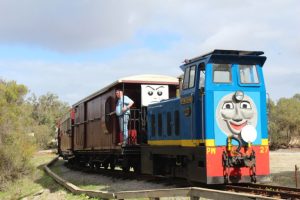
Built to 3’6″ gauge for the WA Public Works Department (PWD) in 1964. Originally allocated to Derby as NW17 , the locomotive was renumbered PW27 and transferred to work the jetty and meatworks at Wyndham. It served in this role until the early 1980s.
The PWD and Shire of Wyndham donated the locomotive to BBR in 1984, where it was regauged to 2ft and commissioned into service in 1986. The locomotive has served BBR until around 2013, when a major transmission failure rendered it unserviceable.
This locomotive is currently out of service, under overhaul.
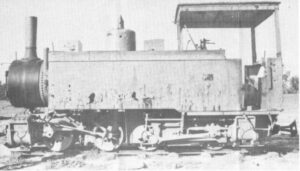
Built in 1901 and first used the Magnet Silver Mining Co in Tasmania. It operated at The Galena mine, approximate four miules south west of Mt Bischoff.
The Mallet for much of its life has been stored in an adjoining shed to the BBR Loco Shed with minimal restoration occurring due to other priorities. The BBR Committee is seeking funding for further restoration through Lotteries and Heritage grants.
Much has been done on the Mallet with the chassis currently in a complete overhauled running condition and able to be operated on Air.
The Boiler has had work on firebox plates, wrappers etc as well as general cleaning, preservation and is ready for tubing. A main issue yet to be solved with the boiler is the lack of two sight glasses which are now required under the current boiler codes.
The Mallet is classified by the National Trust of Australia (WA)
Rolling Stock
The BBR has a diverse range of rolling stock, comprised of Passenger Coaches, Freight Wagons, Industrial Skips & Hoppers and Permanent Way Equipment.
These vehicles have been acquired, modified or custom-built by the railway over the last 30 years. All wagons are ex-WAGR (3’6″ gauge, re-gauged to 2ft) unless otherwise specified.
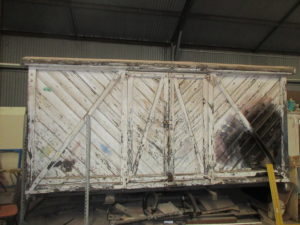
General purpose covered freight wagon. Built in 1891 for the Midland Railway of Western Australia (M.R.W.A.) by the Lancaster Wagon Company, UK. It was written off in 1965, having never been taken into WAGR stock after its 1964 takeover of the MRWA. The grounded body was purchased by BBR members in the 1980s. Restoration is ongoing.
This wagon is a unique survivor of the longest-lived privately owned common carrier railway in WA.
Further information on the class can be found HERE.
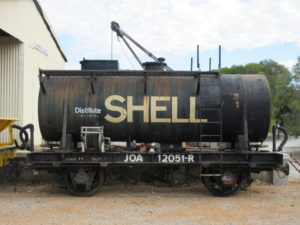
Fuel Oil tank wagon converted in 1967, using steel frames from CXA sheep wagon (12051) and oil tank from a scrapped wooden-framed JOA tanker (number unknown). This wagon was written off in 1988, and subsequently purchased by BBR. Regauging to 2ft and restoration was completed in 1990.
This tank wagon is currently used to carry water, and can act as a supplemental water tender for steam locomotives. It also has a pump and hose unit for fire suppression purposes.
More information on the class can be found HERE.
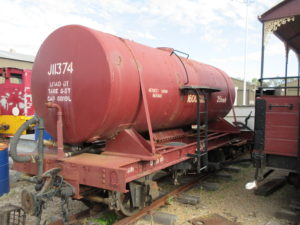
Chromate Water tank wagon converted in 1970, using steel frames from CXA sheep wagon (11374) and water tank from an older, scrapped J tanker (number unknown). This wagon was written off in 1988, and subsequently purchased and restored by the BBR in 1992.
This tank wagon is currently used to carry water, and can act as a supplemental water tender for steam locomotives. It also has a pump and hose unit for fire suppression purposes.
More information on the class can be found HERE.

General-purpose covered freight wagon. Built by in 1907 with a 15’0″ underframe. Rebuilt by the WAGR’s Midland Workshops in 1953 with a longer 16′ underframe. Written off by the late 1970s, with the wagon body subsequently being used as an explosives store at WAGR’s Midland workshops. Details on the class can be found HERE.
This wagon’s body was purchased by BBR members from salvage in 1994. Restoration using underframes from an LA class ballast wagon was completed in 1995. D33 is used for storing track gang equipment, and is finished in an eye-catching McPherson’s Tools advertising scheme that was originally worn by DA Van 10962 in 1958.
General-purpose covered freight wagon. Built by Gloucester Railway Car and Wagon Co to a New Zealand design in 1895 – Classified D and then later reclassified DW when it was transferred to Departmental use as a Workmens’ van. It was written off in the late 1960’s and was put to use as a grounded body on a property on Middle Swan Rd Caversham. The Main Roads Department of WA donated the wagon to the BBR in the mid-1980s. Restoration Pending.
More information on DW class vans can be found HERE.

The Government of West Australia authorised major expansions of its country branchline network after the First World War. To improve the quality of transport offered to settlers in these newly-connected regions, the WAGR authorised the construction of ZB class Brake Vans between 1926 and 1933. ZB213 was built by the Metropolitan Carriage Works, Manchester UK, and entered service in 1927.
ZB Brake Vans were run as part of Mixed (Passenger and Freight) trains, to provide accommodation for travellers to and from remote country stations. The class was retired from passenger duties in the late 1950s as country rail services were contracted. ZB Brake Vans were steadily withdrawn between 1950 and 1985. ZB213 was withdrawn in 1977.
ZB213’s body was stored in Kewdale Yard until it was donated to BBR by Pacific National in the early 1990s. Detailed restoration of the wagon’s body and frame to operational condition was completed in 2019. Work on brakes and drawgear is underway.
Further information on the class can be found HERE.
When completed, ZB213 will provide visitors to the railway a taste of country passenger travel during the interwar years age in WA.
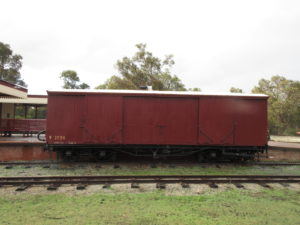
Built by Birmingham Railway Carriage & Wagon Co., Birmingham UK in 1898. Written off in 1972. This wagon was one of 10 bogie goods wagons loaned permanently to BBR by Westrail in the late 1980s for preservation and operation. Details on the class can be found HERE.
This wagon is used for storing spare items and equipment for various projects, as required by the railway’s operating departments. It has also been used on demonstration goods trains from time to time.
Signals & Safeworking
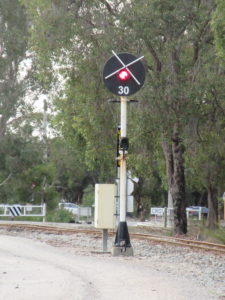
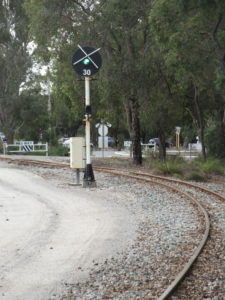
Colour Light Signals- ‘Danger’ (Stop) and ‘Clear’ (Proceed)
Colour Light signals were introduced into WAGR service in the late 1940s, with the introduction of Centralised Traffic Control (CTC). This ‘Searchlight’ type of signal has been used until recently on former WAGR mainlines and in the suburban area.
The southern half of the Bushland Loop and approach to Whiteman Village Junction from Mussel Pool is signalled with Colour Light signals, which light up as a train approaches. If the line ahead is clear, a Green aspect will be shown to the train driver. If it is not, a Red aspect will be displayed and the driver will need to stop the train.
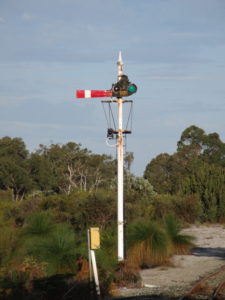
Automatic signalling was used to improve traffic capacity on the old Eastern Railway region between Koojedda and Bellevue between 1926 and 1966. These were Upper quadrant, 3 position electric signals from the General Railway Signal Company in the USA. The patent for these signals is dated 1918.
Upper Quadrant signals are installed at Zamia station, halfway along the Bushland Loop. The signals will activate as a train approaches from either end of the station, and show a ‘Caution’ and then a ‘Clear’ aspect if the line ahead is unoccupied. Trains are permitted to pass these signals if they are at ‘Danger,’ after having come to a stop and waited for several minutes. This is the same practice historically used on the Bellevue-Koojedda section.
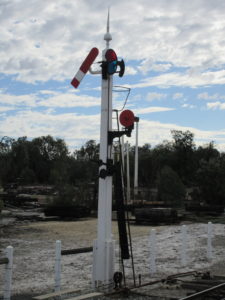
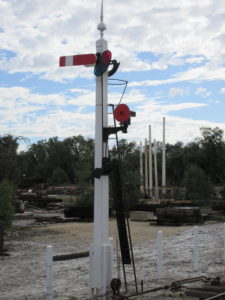
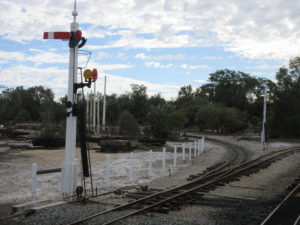
Home Signal- ‘Danger’ (Stop), ‘Clear’ (Proceed) & Shunt Signal at ‘Caution’ (Proceed slowly, ready to stop short of obstruction)
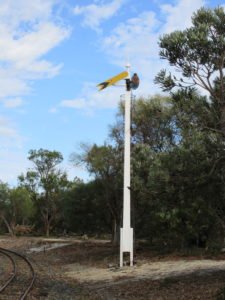
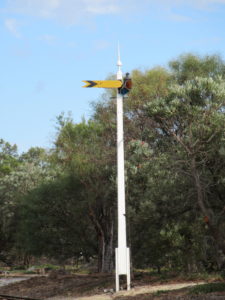
Distant Signal- ‘Caution’ (Prepare to Stop) & ‘Clear’
The Bennett Brook Railway is home to the only operating Lower Quadrant semaphore signals in West Australia. The WAGR adopted McKenzie & Holland ‘Somersault’ signals at its formation in the 1880s. These unique and rare semaphore signals were also used in Victoria.
As of May 2020, Mussel Pool station and the Northern end of Whiteman Village Junction station are fully signalled, with all trains operating under the guidance of the lower quadrant signals found there.
Other signal masts are to be found around the northern and southern approaches to Whiteman Village Junction, some of which are operable and others still to be commissioned.
Mussel Pool’s signals are operated mechanically from the signal cabins using Signal Wire and pulleys. The semaphore signals at Whiteman Village Junction are operated by electric signal motors. This allows signals to be operated centrally from the Signal Box, or Automatically by train crews when the signal box is unmanned.
Wig Wags
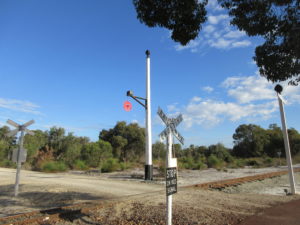
Wig Wags are an active level crossing protection system that originated in the USA. These systems were widely used across Queensland , South Australia and Victoria as their first active level crossing protection systems. When activated by an approaching train, a red light comes on in the wig wag ‘target,’ which is swung back and forth by an electric motor. A bell sounds in time with the swings.
Only one such system was employed in West Australia- At the Meadow Street level crossing in Guildford. This was installed in 1925, and was replaced by flashing lights and bells in 1948.
The Wig Wag installation on the Bushland Loop is a replica of this system. It was commissioned in 2006.
Flashing Lights & Bells

Flashing lights and bells have been employed in West Australia since the 1930s. Equipment used by the WAGR was purchased from Westinghouse Signal Company and McKenzie & Holland. Multiple examples of this type of crossing protection can be seen on the Bushland Loop.
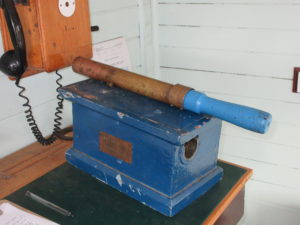
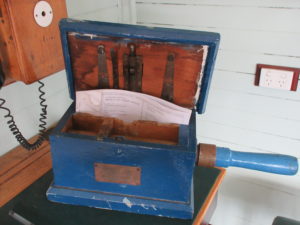
Train Staff and Ticket Box- Mussel Pool
Staff and ticket is the safe working method employed on the Bushland Loop.
The driver must be in possession of the staff for the section at any time his train is outside the Whiteman Village Junction station limits.
If two trains are to travel in the same direction on the Bushland Loop, a ticket is issued by the signalman indicating the date and time of issue and type of train. The ticket is given to the driver of the first train who accepts it providing he is shown the staff for the section. The driver of the second train receives the staff with a copy of the ticket attached.
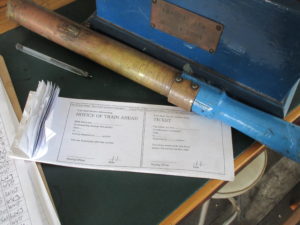
Ticket Pad containing Notice of Train Ahead (L) and Ticket (R)- Mussel Pool Station
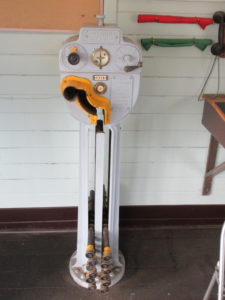 Large Electric Train Staff Instrument- Mussel Pool
Large Electric Train Staff Instrument- Mussel Pool
Electric Train Staff is the safe working method employed on the Mussel Pool line. Electric Train Staff working was once used extensively throughout the WAGR system. It was fully supplanted in the 1990s by Train Order working via 2-way radio on remote branch lines, and CTC on all main lines. The BBR electric staff is the only working installation now remaining in WA, and possibly the only such working example on a tourist or heritage railway in Australia.
Large electric staff instruments are located in the Mussel Pool and Whiteman Village Junction signal cabins. The driver must be in possession of a staff for the section any time his train is outside the station limits of Mussel Pool or Whiteman Village Junction. There are a total of 16 staffs housed in the staff instruments. If the line is clear, a staff is withdrawn from the instrument and given to the driver. Once a staff is removed from either instrument, both instruments are locked and no other staff can be removed. When the train reaches the other end of the section, the staff is returned to the instrument at that end and both instruments are unlocked indicating the line is clear. Another staff can then be removed.
How it Works
The staff instruments at Mussel Pool and Whiteman Village Junction are electrically connected by one pair of wires of the open aerial pole route between the signal cabins. At each end there is a battery providing power to the instruments.
When the line is clear, the batteries at each end are connected in opposition. There is no current flow over the pole route and the galvanometer needle on each instrument is vertical indicating the line is clear.
 Staff IN- Line is clear
Staff IN- Line is clear
To remove a staff, two electromagnets in the instrument need to be energised in the same direction to lift the latch enabling a staff to be removed. As the staff is moved into the gate, the local battery energises one electromagnet (local coil) and the battery at the other end energises the second electromagnet (line coil). If the line is clear, both coils lift the latch to enable the staff to be removed. Removal of the staff reverses the electrical connection between the instruments and current flows over the pole route. The needle in the galvanometer on each instrument is moved to 45 degrees indicating the line is occupied.
 Staff OUT- Line occupied
Staff OUT- Line occupied
A second staff cannot be removed as the current through the line coil and local coil are in opposition preventing the latch from being lifted.
If the aerial pole route is broken, a staff cannot be removed as only the local coil is energised and this is insufficient to lift the latch.
Track
This Section is currently under construction
Structures
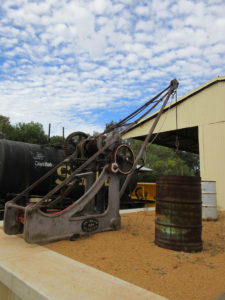
This crane was constructed by A & J Inglis of Glasgow. This company was formed in 1848 as an engineering works, and in 1863 turned to shipbuilding. The company went on to become one of the biggest shipbuilders on the Clyde before finally becoming defunct in 1963.
The crane has an approximate capacity of 1 ton. It was acquired by the WAPC ( Western Australian Planning Commission) sometime in the early 1980s. It was initially displayed in Whiteman Village, then passed on to BBR for restoration and inclusion with the Parkers Siding Goods Shed and Loading Dock at Mussel Pool.
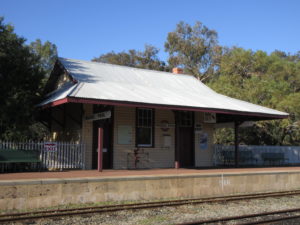
The initial trackwork and platform for Mussel Pool station was laid down in 1984. By 1988, the current track layout was complete and the station precinct was comprised of the former Pingelly bus shelter (now at Kangaroo Flats) and the Collie signal box (Donated to Collie Mens’ Shed in 2018, and under restoration). In 1987, WALRPA purchased the Nungarin station building from Westrail and with the assistance of the Australian Army Reserve’s 22nd Construction Squadron, moved it to Whiteman Park in late 1989. The station building was officially opened on the 3rd of March, 1991.

Nungarin is a location 280km East of Perth and 40km north of Merridin on the Eastern Railway. The line still serves the Central Wheatbelt to this day. The station building was known by WAGR as a ‘Traffic Office,’ and provided a simple and cheaply built workspace for a local Station Master. The design had no passenger amenities, and did not usually have a raised platform. The Nungarin building is unique as it is the only Traffic Office ever made of wood- All its contemporaries were brick structures.
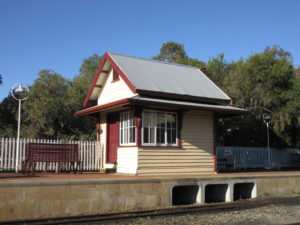

Ex-Cottesloe Signal Cabin and Plaque detailing the history of Mussel Pool Signal Cabin and Lever Frame
Cottesloe Signal Box
The Mussel Pool Signal Box was originally the second of three boxes that controlled suburban passenger and freight train movements in the suburb of Cottesloe. It was opened in 1903, and replaced by a larger signal box in 1931. The building was repurposed, first as the Passenger Yard Foreman’s Office and then the Linen Room at Perth Station. In this latter role, the building stored all sheets and tablecloths, etc. used on the WAGR’s long-distance passenger trains until their demise in 1978. Further information on the Signal Cabins at Cottesloe can be found HERE.
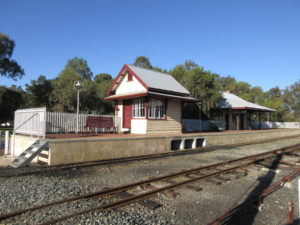
WALRPA acquired the building in 1987, and transported it intact to Whiteman Park in 1988. The building was originally placed at the current location of Parker’s Siding until 2011. It was then used to replace the Collie cabin and lever frame in 2012.
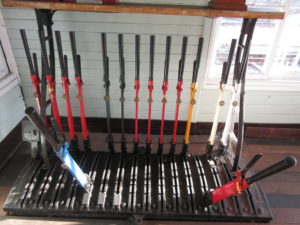
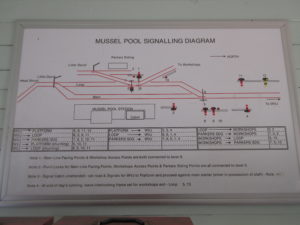
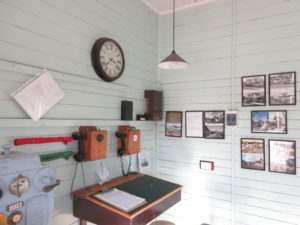
Wagin ‘A’ Lever Frame; Signalling Diagram for Mussel Pool; Interior View of Signal Cabin behind the Lever Frame
Wagin ‘A’ Lever Frame
The Wagin ‘A’ Station Frame (Signal and Point levers not placed in a Signal Cabin and operated by Station staff, thus obviating the need- and cost- of a separate Signalman) was commissioned in 1968 to control train movements in the southern (Albany) end of the yard. Two other frames (both preserved) controlled the station precinct and northern (Perth) end of the yard, respectively. These frames were decommissioned in 1994, and the ‘A’ frame purchased for eventual use at the Bennett Brook Railway. Further details on the Wagin signalling arrangements and plant can be found HERE.
The frame was restored and made operational in 2011, then combined with the ex-Cottesloe Signal Cabin in 2012. The Cabin and Frame were commissioned on May 19th 2013, and have controlled train movements into and out of the station since. This location has the only remaining working mechanical signalling and interlocking arrangements in West Australia.
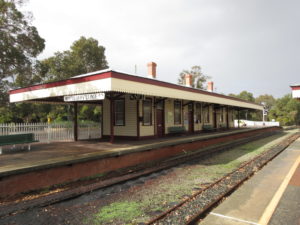
The Station building on WVJ Platform 1 was part of the original station at East Perth, renamed Claisebrook in 1969. This building was decommissioned in 1984, purchased for the Bennett Brook Railway by the then Metropolitan Regional Planning Authority (now WAPC), and moved to Whiteman Park.
The station was originally named Central, and became Whiteman Village Junction in 1992. The station is the base for all passenger train operations conducted on the BBR, as well as Party Coach bookings.
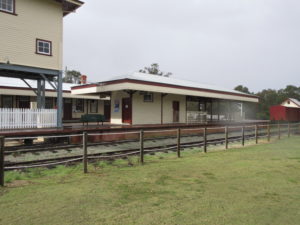

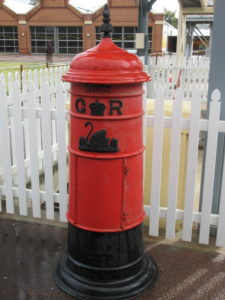
Subiaco Station Shelter; Facing towards Mussel Pool from WVJ Platform 2, under Subiaco roof; WA General Post Office mailbox, WVJ Platform 2/3
The buildings on WVJ Platforms 2 and 3 are the former Subiaco Station and Signal Cabin. The Station building was commissioned in the 1890s, replacing a smaller shelter originally erected in 1883. It served commuters moving between Perth and Fremantle.

The Subiaco Signal Cabin is the second of 2 Cabins that existed at this location. It was commissioned in 1923, was destroyed by fire in April 1956, completely rebuilt by May the same year, and was one of only 2 cabins to survive the electrification of the Perth suburban railway network in 1990.
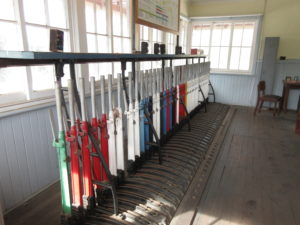

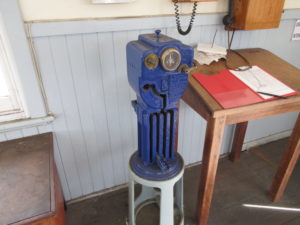
Subiaco Lever Frame; Party Line telephones; Train Register Desk and Miniature Electric Train Staff Instrument (Non-functional)
Subiaco Station and Signal Cabin were decommissioned in 1998, acquired by WALRPA and moved to Whiteman Park. The Subiaco building currently stores all materials used in the Party Coach area on Platform 3.
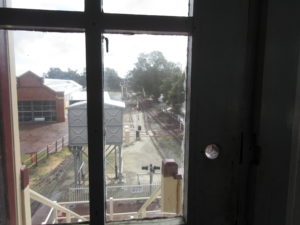

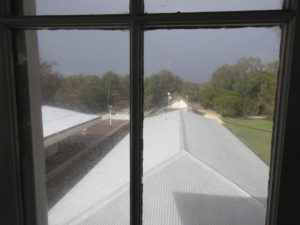
View from signal box, looking North; WVJ Signalling Diagram; View from signal box, looking South
With the completion of the WVJ signalling project, it is expected that the Subiaco Cabin will be commissioned into service in 2021.


The water tank in use at WVJ is a composite structure made up of a tank thought to be from the Midland abattoir (purchased from a Hazelmere salvage yard), and a water crane arm recovered in 1992 from the former Formby siding, a WAGR watering place on the Gnowangerup line. This tank was chosen for BBR use, as any actual ex-WAGR water tanks would have been too large and impractical for the railway’s needs.
Restoration of these pieces started in mid-2008, and by late 2009 all parts were ready for assembly. Roofing and final erection was completed in November 2011.
The tank provides water storage for BBR steam locomotives, with water filling being completed by hydrant fitting near Platform 1, or by the crane on Platform 3.
A free-standing water column from Gnowangerup was also preserved in 1992, and it is hoped to one day have this available for locomotive watering purposes.
